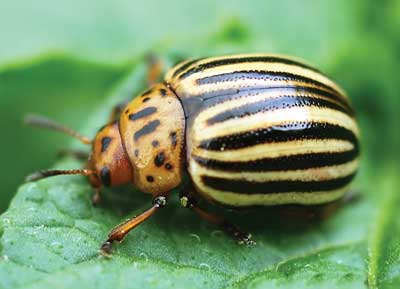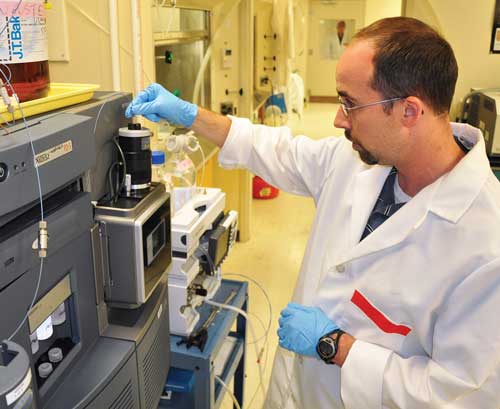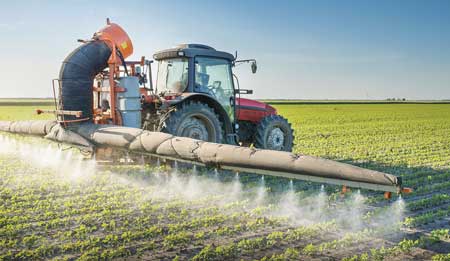Pesticide Analysis
FOOD SAFETY & QUALITY
 Pesticides are designed to kill pests such as weeds, insects, fungi, molds, and rodents, but residues left on or in foods also have the potential to affect humans. For that reason, regulatory agencies set maximum levels for residues to ensure that the use of the pesticides does not adversely affect the health of humans, especially infants and children.
Pesticides are designed to kill pests such as weeds, insects, fungi, molds, and rodents, but residues left on or in foods also have the potential to affect humans. For that reason, regulatory agencies set maximum levels for residues to ensure that the use of the pesticides does not adversely affect the health of humans, especially infants and children.
U.S. Environmental Protection Agency
All pesticides sold or distributed in the United States must be registered with the U.S. Environmental Protection Agency (EPA). Companies developing a new pesticide, a new pesticide active ingredient, or a new application of an existing pesticide must apply for registration by submitting the identity and quantity of all chemicals in the product; data from studies on potential risks to human health and the environment, including the potential for pesticide residues on food; proof that the manufacturing process is reliable; and labeling information, including usage directions, contents, and appropriate warnings.
After receiving the application, the EPA publishes a Federal Register notice of receipt, reviews all the scientific data on the pesticide, conducts a comprehensive risk assessment of the potential effects on humans and the environment, conducts a peer review of the risk assessment by scientific experts, sets a maximum legal residue limit (tolerance) above which enforcement action such as seizure is triggered for each treated food, requests public comment, and then either requests changes or grants the registration and publishes a notice to that effect. The EPA reviews each pesticide registration at least once every 15 years.
In estimating the potential risks of pesticide residues in food, the EPA uses a worst-case scenario: the agency assumes that a pesticide is applied at the maximum level permitted by the usage directions on every acre of each approved crop at the maximum rate and frequency allowed and that residues on treated crops are present at the maximum allowed level. If the resulting estimate, which likely significantly exceeds the actual exposure, indicates a potential risk of concern, the agency refines its assessment using realistic exposure data determined by using data on the percentage of a crop treated with a pesticide; studies on the effects of washing, cooking, processing, and storage; and information on how much pesticide residue remains on various foods obtained via the U.S. Dept. of Agriculture’s Pesticide Data Program.
As part of the registration application, companies must provide methods for analysis of the pesticide and pesticide residues for confirmatory purposes and enforcement purposes. These methods are used to obtain residue data on which dietary exposure assessments and tolerances are based and to enforce the tolerance after it is established. The enforcement methods must be validated by an independent laboratory before submission to the EPA.
The EPA does not list the specific types of analytical methods that are acceptable for enforcement of tolerances but indicates that any procedure that meets the criteria would be acceptable. The agency encourages use of methods such as the multi-residue methods published in the Pesticide Analytical Manual, volume II, and the Official Methods of Analysis of AOAC, which includes 210 official methods of analysis related to pesticides. Methods based on cholinesterase inhibition, the EPA says, are not considered suitable for enforcement purposes. Methods based on paper or thin-layer chromatography that visually measure the residue may not be quantitative enough for enforcement purposes but may be useful as confirmatory methods to help identify the residue. Methods based on certain gas and liquid chromatographic detection systems should usually be supplemented by a confirmatory method significantly different from the primary enforcement method. In general, confirmation by mass spectrometry is suitable, and the specificity can be enhanced by the use of special extraction/cleanup procedures, derivatization, or parallel and/or alternate columns.
 U.S. Food and Drug Administration
U.S. Food and Drug Administration
The U.S. Food and Drug Administration (FDA) enforces the tolerances established by the EPA for amounts of pesticide residues on food and feed. To do this, it collects and analyzes food samples from commercial channels. The analytical methods the FDA uses in its laboratories are published in the agency’s Pesticide Analytical Manual. Volume I describes multi-residue methods used because of their efficiency and broad applicability, especially for analyzing foods of unknown pesticide treatment history. Volume II contains methods for the analysis of residues of only a single compound. These single-analyte methods are most often used when the likely residue is known and/or when the residue of interest cannot be determined by commonly used multi-residue methods. Most methods in volume II were developed by pesticide registrants to fulfill the requirement that a method suitable for enforcement be available.
The FDA says that detectable pesticide residue on a fruit or vegetable does not mean the food is unsafe. Small amounts of pesticides that may remain in or on fruits, vegetables, grains, and other foods often decrease considerably as crops are harvested, transported, exposed to light, washed, prepared, and cooked.
--- PAGE BREAK ---
U.S. Dept. of Agriculture
Since 1991 the Agricultural Marketing Service (AMS) of the U.S. Dept. of Agriculture (USDA) has been measuring residues for hundreds of pesticides and their metabolites in fruits, vegetables, grains, meat, and dairy products from the United States and other countries through its Pesticide Data Program (PDP). After discussion between EPA and USDA specialists and consideration of the USDA’s scientific input and the EPA’s data needs, the EPA makes the determination of which commodities and pesticides are tested. Samples are collected by 10 states representing about 50% of the nation’s population and all regions of the country. Seven of those states and the USDA-AMS National Science Laboratory provide laboratory testing services. Standard operating procedures ensure consistency between laboratories, and a program-wide proficiency testing program monitors the performance equivalency of the participating laboratories.
The laboratories use a modified version of the quick, easy, cheap, effective, rugged, and safe (QuEChERS) method to extract pesticides and pesticide residues from the samples. The extraction method was originally developed by the USDA cooperatively with the FDA to extract residues from fruit and vegetable samples for use as a multi-residue method for pesticide screening. The exact method used by participating laboratories can vary depending on commodity, but all follow the same basic steps, as outlined in AOAC method 2007.01 with modifications: A mixture of acetonitrile and water (for dry commodities) or acidified acetonitrile (for high-moisture fruits, vegetables, and other samples with high water content) is used to extract a wide range of pesticide residues from the sample. The sample and solvents are then treated with an extraction media to isolate the pesticide residues in the acetonitrile. The extract is cleaned using dispersive solid phase extraction, then analyzed by capillary gas chromatography time-of-flight mass spectrometry(GC/TOF/MS), ultra-performance liquid chromatography tandem mass spectrometry (UPLC/MS/MS), or gas chromatography tandem mass spectrometry (GC/MS/MS).
Results of the PDP testing are published in annual reports presenting statistics on the number of pesticide residues detected, the number of residues exceeding the EPA’s tolerances, and the number of residues detected for which no tolerance has been established. To date, the PDP has tested 112 different commodities and more than 450 different insecticides, fungicides, herbicides, and growth regulators. The annual report for 2013, published in December 2014, showed that more than 99% of the products sampled had residue levels below the EPA tolerances. PDP data show that there has been an overall decrease in the amount of pesticide residues in food, especially since the passing of the Food Quality Protection Act in 1996, and that there has been an overall trend of reduced risk from pesticides through stricter standards, major improvements in science, and an increase in the use of safer, less toxic pesticides.
 Advances and Challenges
Advances and Challenges
USDA and FDA representatives shared what they considered the most recent advances in methods for testing for pesticide residues on food and the major challenges ahead.
• Advances. A USDA spokesperson said that pesticide residues typically have been monitored using GC and LC instruments coupled with selective detectors. The use of MS detectors has rapidly increased in the last few years. Now, with the use of MS/MS coupled with GC and LC systems for analyte separation, hundreds of pesticides can be analyzed in a single test. With recent advances in GC/MS/MS and LC/MS/MS instrumentation, these techniques are quickly gaining worldwide acceptance for pesticide residue testing.
To use these systems effectively, the sample must first be extracted to ensure the maximum recovery of potential analytes. The QuEChERS method has been adopted around the globe and is the most commonly used analytical extraction approach in pesticide residue analysis today. It provides high recoveries for a very broad scope of pesticides belonging to various chemical classes.
An FDA spokesperson said that a novel procedure for testing pesticide residues utilizing high-resolution MS technology has been developed and is being evaluated for implementation in FDA laboratories. Current and standard procedures employed by pesticide laboratories around the world, including the FDA, utilize a targeted approach to screen and quantitate a targeted number of pesticides. This has limitations because more than 1,000 different pesticides as well as other chemical contaminants can potentially be present in food. The use of high-resolution MS allows analysts to screen for not only targeted pesticides––those pesticides that have a high probability of being present in the food due to regulatory allowance, surveillance, and intelligence gathering––but also pesticides and other chemical contaminants that are unsuspected or unexpected to be present or found in particular and various food products.
The high-resolution MS in conjunction with LC works by scanning for particular masses (mass/charge) typical of pesticides in the 100–1,000 molecular weight range as long as the pesticide can be separated and ionized. Since these instruments also have the capability of providing high-mass-accuracy information for the pesticide and its molecular products by breaking apart the original pesticide molecule into smaller unique and distinguishable molecular mass fragments, the likelihood or probability that there is another molecule with the same chromatographic retention time, exact molecular weight (to more than three or four decimal places), and the same product pattern to obtain a high-mass-accurate molecular fingerprint is very close to zero unless these compounds are isomers (which are few). This high-resolution/high-accuracy procedure also allows for the building of high-quality mass-spectral libraries of pesticides that provide additional confidence in unambiguous identification because reasonable molecular structures can be assigned to the molecular products based on the theoretical and likely fragmentation of the pesticide. Typically, an authentic standard is used as a reference to ensure that there is a match between the suspected pesticide found in the food and the authentic standard. This library database of pesticides and pesticide molecular fingerprints will be helpful in identifying these unexpected pesticides because in many situations a reference standard is usually unavailable at the time of screening and detection.
This procedure is being developed at FDA laboratories for analysis of not only pesticides but also other chemical contaminants such as mycotoxins and veterinary drugs. It is the hope that generic sample-preparation procedures along with chromatographic techniques coupled with high-resolution MS can be developed, validated, and implemented in FDA and partner laboratories to analyze for pesticides and a wide variety of chemical contaminants in food that could be harmful to the consumer.
• Challenges. The USDA spokesperson said that increasing globalization of agricultural production presents unique challenges to pesticide residue testing. A wider variety of pesticides are being used with varying regulations on allowable levels for pesticide residues. The PDP conducts regular assessments to ensure that it is targeting things appropriately. The need to increase the range of testing capabilities must also be balanced against budgetary considerations, since GC/MS/MS and LC/MS/MS instrumentation is costly and requires experienced users.
The FDA spokesperson said that with a global economy, getting U.S. tolerances for minor crops grown elsewhere in the world and imported into the United States is a huge challenge for the FDA and the EPA. It is expensive to register a pesticide for use on a crop since it involves a registration fee, field trials, toxicology studies, and so on, and there is often not enough return on investment for chemical companies to register use on minor imported crops.
--- PAGE BREAK ---
Papers Addressing Pesticide Analysis
•“Pesticide Identification and Analysis Using Atmospheric Pressure Gas Chromatography Mass Spectrometry,” presented by Kelly Dorweiler at the 2014 IFT annual meeting.
•“Applications of SERS for Pesticide Detection in Food,” presented by Shintaro Pang at the 2014 IFT annual meeting.
•“Core-Shell Particles as Electrode Material for Pesticide Biosensors,” presented by Lia A. Stanciu at the 2014 IFT annual meeting.
•“Comparative Degradation Study of Pesticide Chlorpyrifos and Herbicide Diuron in Aqueous Solutions by Fructose, TiO2, H2O2 Photocatalysis Using UV Light,” presented by Shaila Nayak at the 2015 IFT annual meeting.
•“Efficacy of Electolyzed Water to Degrade Pesticides,” presented by Hang Qi and Yen-Con Hung at the 2015 IFT annual meeting.
•“Use of Graphene and Gold Nanorods as Substrates for Detection of Pesticides by Surface-Enhanced Raman Spetroscopy,” presented by Trang Nguyen et al. at the 2015 IFT annual meeting.
Services and Instrumentation
Some analytical laboratories offering pesticide testing services are the following:
• ABC Research Laboratories, Gainesville, Fla. (www.abcr.com)
• Anresco Laboratories, San Francisco, Calif. (www.anresco.com)
• Eurofins Central Analytical Laboratories, New Orleans, La. (www.eurofinsus.com)
• Medallion Laboratories, Minneapolis, Minn. (www.medallionlabs.com)
• Merieux NutriSciences, Chicago, Ill. (www.merieuxnutrisciences.com)
• Microbac Laboratories, Pittsburgh, Pa., (www.microbac.com)
• NP Analytical Laboratories, Saint Louis, Mo., (www.npal.com)
Manufacturers offering equipment include the following:
Agilent Technologies Inc., Santa Clara, Calif. (www.chem.agilent.com), offers the 7000C GC triple-quadrupole GC/MS system, which features a database of eight multi-residue methods for more than 1,000 pesticides and other toxic contaminants; the 5977 single-quadrupole GC/MSD featuring deconvolution reporting software and a retention-time-locked pesticide and endocrine disruptor library for screening 927 pesticides in a single analysis; and the 7200 Series GC/Q-TOF analyzer, which can simultaneously screen for more than 700 pesticides.
PerkinElmer Inc., San Jose, Calif. (www.perkinelmer.com), offers the Clarus SQ 8 GC/MS system, which is engineered around the Clarifi detector that allows the user to choose the sensitivity and dynamic range, and SMARTsource, which allows users to completely remove the ion source and lenses of the MS system for maintenance and to easily reconfigure between electron ionization and chemical ionization modes. The system also is said to feature the fastest conventional GC oven available, TurboMass software for data collection and reporting, and the TurboMatrix sample-handling system.
Shimadzu Scientific Instruments Inc., Columbia, Md. (www.shimadzu.com), offers the LCMS-8060 triple quadrupole mass spectrometer, the newest model in the company’s UltraFast Mass Spectrometry series. The LC/MS/MS instrument features the company’s UltraFast technologies, a stronger vacuum system, and a redesigned UF-Qarray ion optical system for high sensitivity in both multiple reaction monitoring and scan modes. It provides high-speed acquisition of both quantitative and qualitative data in a single run.
Thermo Scientific Inc., Waltham, Mass. (www.thermoscientific.com), offers its TSQ 8000 Evo GC-MS/MS Pesticide Analyzer, featuring preloaded GC/MS/MS and data processing methods and a database of more than 600 pesticide compounds. The company also offers its HyperSep Dispersive SPE sample-preparation kits for extraction and cleanup of pesticides from complex matrices using the QuEChERS method.
Waters Corp., Milford, Mass. (www.waters.com), offers its Pesticide Screening Application Solution for routine detection, quantification, and reporting of pesticide residues in complex food matrices. It consists of the Acquity UPLC I-Class liquid chromatograph that provides high-resolution separations that help to resolve components of interest from complex matrix interference peaks and a repeatable retention time for compound identification; the Xevo G2-S QTof, which provides the ability to obtain both accurate mass precursor ions and fragment ions from a single injection; and the UNIFI Scientific Information System, which combines all the components necessary for effective residue screening, including data acquisition, processing, and management, and an extensive pesticide scientific library.
 Neil H. Mermelstein, IFT Fellow,
Neil H. Mermelstein, IFT Fellow,
Editor Emeritus of Food Technology
[email protected]


